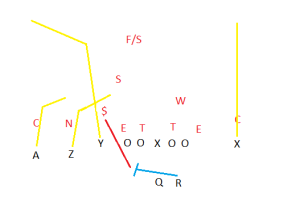If you asked Stanford fans for predictions ahead of Friday’s game against then-No. 8 UCLA, you would probably get doom and gloom. Jim Mora’s Bruins were arguably the greatest UCLA team in 20 years, while Stanford was enduring a rebuilding year. But because this is Stanford football and you never know what to expect, Stanford ran the star-studded Bruins out of their own stadium in a 31-10 thrashing. It was Stanford’s finest performance of the season. It was also the first time all season that Stanford had defeated a ranked opponent.
What did Stanford do well? Primarily, it was execution. The much-maligned Stanford offense – just two games removed from 10 straight scoreless possessions against Utah – was clicking on all cylinders. In particular, quarterback Kevin Hogan was absolutely on fire, slashing apart UCLA’s man coverages to move the Cardinal down the field over and over again. It was arguably the finest performance of his life.
***
This 25-yard completion to tight end Austin Hooper exemplifies much of the success of Stanford’s offense on Friday. It showed playcalling that put players in position to win. It showed good pass protection, especially from the running backs. And it showed a great throw from Kevin Hogan, one that let UCLA know that Stanford had come to play. (Online readers can see the video here.)
The play took place early in the first quarter; UCLA had just marched down the field against Stanford’s vaunted defense, and while the Cardinal would adjust brilliantly, bottling up the high-powered Bruins for the rest of the game, Stanford’s offense needed some momentum. This throw helped Stanford build that momentum.

UCLA’s lined up in man coverage at the snap: With Stanford’s star wide receiver Ty Montgomery out for the game, UCLA defensive coordinator Jeff Ulbrich felt that he could get away with playing man-to-man on Stanford’s receivers, freeing up other players to guard against scrambles, focus on stopping the run and rush the quarterback. Here, UCLA is in a Man-Free look, meaning that all of Stanford’s eligible receivers (A, Z, Y, X and R) are assigned one player in coverage, and the free safety (F/S) cleans up any coverage breakdowns that occur. It’s a risky call, and Stanford made the Bruins pay for their disrespect.
What you see here is a solid route combination against the man coverages that UCLA insistently fielded and would continue to field for much of the game. The double slants by Francis Owusu and Devon Cajuste (A and Z) are a popular man beater. Meanwhile, tight end Austin Hooper (Y) ran a deep corner route behind them, attacking the open space that the man-to-man look gave near the sideline; UCLA’s deep safety would try to help out, but he was stuck in the middle of the field, and, going to the sideline, Hooper would have the advantage. As it turned out, Owusu and Cajuste both got open for a potential first down, one of many times that Stanford’s receivers proved Ulbrich wrong. But Hooper got a step on his man (S), and knowing that an incomplete would just lead to an extremely manageable third down, Hogan threw deep.
But Hogan wouldn’t have had time to make a deep throw if his protection had been poor. Against UCLA, Stanford’s pass protection was as good as it had been all season. In particular, while UCLA tried to disguise their safety blitz by making it look like safety Anthony Jefferson ($) was covering Hooper, running back Remound Wright (R) was quick to diagnose Jefferson’s blitz, even though Wright was on the opposite side of the pocket. You normally don’t want to have a back cross the QB’s face while he’s trying to throw, but sometimes that’s exactly what you have to do, and Wright made an athletic block on Jefferson that made Hogan’s throw possible.
All that was left was for Kevin Hogan to unleash one of his finest throws of the season. Hooper was 25 yards deep and on the opposite side of the field, and Hogan hit him where only Hooper could make the catch. UCLA’s man coverage and Stanford’s underrated receivers gave Hogan the opportunities he needed to make big plays, and with solid protection in front of him, Hogan was extremely on point, making tough throws all game. He wasn’t perfect, and at times he got lucky, but he torched UCLA’s secondary nonetheless. (He would later top this throw with a beautiful dime to Michael Rector to put the Cardinal ahead, a lead they would not relinquish.)
Will we see that kind of Stanford in its bowl game and down the road? I don’t know. On the one hand, you don’t beat the daylights out of a top-10 team like that without being legitimately good. On the other hand, it is just one game. One thing is for sure: If Stanford can maintain these improvements, its bowl opponent is going to be in for a very, very long day – and Stanford fans are going to have a good time.
Contact Winston Shi at wshi94 ‘at’ stanford.edu
